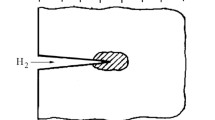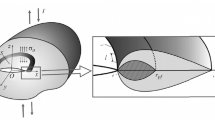Abstract
We propose a computational model of fatigue crack growth in structural elements with inhomogeneous mechanical characteristics. The model is based on the energy criterion of fatigue fracture of materials and a hypothesis that the crack propagates in the direction of the maximum possible rate. The fatigue-crack growth rate is represented as a function of the parameters of loading and strength characteristics of the material. The proposed model is used for the determination of the residual fatigue life of welded structures with faulty fusions. The results of numerical evaluation of residual fatigue life are in good agreement with the experimental data.
Similar content being viewed by others
REFERENCES
A. M. Lepikhin and V. V. Moskvichev, “Characteristics of crack resistance of welded joints–estimation, numerical evaluation, and statistical analysis,” Zavod. Lab., No. 12, 48–51 (1991).
J. Q. Fu and Y. W. Shi, “Mechanical heterogeneity and validity of J-dominance in welded joints,” in: K. H. Schwalbe and M. Kosak (editors), Mis-Matching of Interfaces and Welds (1997), pp. 307–317.
L. M Lobanov (editor), Welded Building Structures. A Handbook, Vol. 1. Fundamentals of the Design of Structures (in Russian), Naukova Dumka, Kiev (1993).
G. P. Karzov, V. P. Leonov, and B. T. Timofeev, Welded Pressure Vessels: Strength and Durability (in Russian), Mashinostroenie, Leningrad (1982).
V. I. Trufyakov, Strength of Welded Joints under Variable Loads [in Russian], Naukova Dumka, Kiev (1990).
O. E. Andreikiv and M. V. Lishchyns'ka, “Equation of growth of fatigue cracks in inhomogeneous plates,” Fiz.-Khim. Mekh. Mater., 35, No. 3, 53–58 (1999).
V. V. Panasyuk, O. E. Andreikiv, O. I. Darchuk, and P. S. Kun, “Analysis of short and long fatigue crack growth kinetics under nonregular loading,” in: K. H. Schwalbe and C. Berger (editors), Structural Integrity: Experiments, Models, Applications, Proc. of the 10th European Conf. of Fracture (ECF-10), Vol. 2, EMAS (1994), pp. 1271–1276.
Y. C. Li and N. C. Huang, “Fatigue crack speed of materials with linear hardening,” Int. J. Solids Struct., 27, No. 7, 865–883 (1991).
V. V. Panasyuk, O. E. Andreikiv, and O. I. Darchuk, “Calculation model of fatigue crack growth in elastic-plastic materials under mixed-mode loading,” in: Abstracts of the 7th Internat. Conf. on the Mechanical Behaviour of Materials (May-June, 1995, Hague), Hague (1995), pp. 119–120.
V. V. Panasyuk, O. E. Andreikiv, and S. E. Kovchik, Methods for the Assessment of the Crack Resistance of Structural Materials [in Russian], Naukova Dumka, Kiev (1977).
J. Morrow, “Investigation of plastic strain energy as a criterion for finite fatigue life,” in: Garret Corporation Report, Phoenix, Arizona (1950), pp. 105–108.
V. V. Panasyuk, Limiting Equilibrium of Brittle Bodies with Cracks [in Russian], Naukova Dumka, Kiev (1968).
Welding in Machine Building: A Handbook [in Russian], Vol. 3, Mashinostroenie, Moscow (1979).
M. V. Lishchyns'ka, “Evaluation of the stress intensity factors in plates near convex curvilinear cracks,” Fiz.-Khim. Mekh. Mater., 34, No. 1, 113–114 (1998).
M. V. Lishchyns'ka, “Kinetics of propagation of broken piecewise-cracks in thin-walled elements under long-term static loading,” in: Mechanics and Physics of Fracture of Building Materials and Structures [in Ukrainian], Kamenyar, Lviv (1998), pp. 126–131.
V. I. Makhnenko and V. E. Pochinok, “Resistance of welded joints containing welds with incomplete fusion to cyclic loads,” Avtomat. Svar., No. 10, 33–40 (1984).
Author information
Authors and Affiliations
Rights and permissions
About this article
Cite this article
Andreikiv, O.E., Lishchyns'ka, M.V. Residual Fatigue Life of Elements with Inhomogeneous Mechanical Characteristics. Materials Science 36, 840–848 (2000). https://doi.org/10.1023/A:1011330620246
Issue Date:
DOI: https://doi.org/10.1023/A:1011330620246




